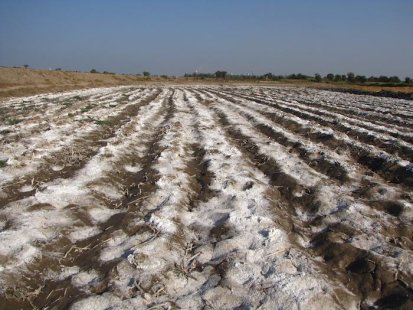
Remediation of saline soil in pistachio garden lands
What is salt?
When the pH and EC in water or agricultural soil increase too much and the effective substances of fertilizers or poisons are quickly blocked in these soils or waters, this soil or water gets agriculturally salty.
Problems in soil and salt water
1-Lack of growth and development of green organs
2- Weak rooting
3-Poor productivity
4-Extremely high statistics of diseases and pests
5-Severe soil erosion
6- Very high water requirement
Factors that cause salinity
1- Indiscriminate use of chemical fertilizers
2- Use of salty water in irrigation
3- Repetition of a type of cultivation and failure to observe fallow
The most obvious signs of saltiness
1-Drying of the edges of the leaves
2- Burning flowers
3-Chlorophyll deficiency (pale color of leaves)
4-Severe drop or even cessation of fertility
5- Running (excessive longitudinal growth and thin collar diameter).
Symptoms and time of salinity in Pistachio trees
Salinity symptoms occur in 3 times of the year, the first time being at the beginning of the season. The years when there is snow and rain in the winter.
In these years, at the beginning of the season, i.e. April, the trees become slightly swollen or turn green, but the tree does not move and its growth stops.
If at this stage we break a branch of the tree and this branch smells of sourness and alcohol, this is caused by saltiness.
In some cases, the tree may turn green at the beginning of the season, but the salinity caused by the rain in April will dry the clusters, tips and edges of the leaves.
The symptoms of salinity may appear during the season and can be seen from mid-June and July, in this case, the edge of the leaf starts to burn and continues to the main leaf, and at the end of July, there will be no green leaves on the tree.
The effects of this salinity on the product are in the form of increased porosity and aggravation of dieback
In salty conditions, the accumulation of salts such as sodium, magnesium, and chlorine reaches such a level that it causes poisoning and the leaves become completely dry.
In the month of Shahrivar, the leaves fall, and the leaves turn green again by watering the tree.
One of the signs of salinity in winter is that tree branches turn purple
A solution to fight against salinity
1-Using washing machine or using chemical fertilizers containing calcium
2- Use of fertilizers containing humic acid, fulvic acid and organic substances
3- Using compost
4 Planting salt-resistant plants
Symptoms of salinity on the leaves of pistachio trees
The burning of tips and edges of leaves is one of the symptoms of salinity in plant tissues. Of course, in the condition of potassium deficiency, the margins of the leaves are also burnt, with the difference that in the case of potassium deficiency, the leaves are brown in color.
Symptoms of salinity in pistachio orchards
Leaf symptoms first appear in older leaves and start from the tips of the leaves and gradually cover the margins. Then it goes to the inner parts of the leaf and the middle nervure.
Signs of salinity on pistachio fruit
As a result of saltiness, the tips of the fruits turn black and plant juice seeps from there.
The long-term effects of saltiness appear in the form of blackening and drying of the whole fruit.
Symptoms of salinity on pistachio kernel
An increase in salinity in the root area of trees may cause insufficient growth of branches, sunburn and pistachio kernel damage.
Poisoning sodium and chlorine elements
The toxicity of sodium and chlorine elements is actually the accumulation of sodium and chlorine ions to the extent of plant poisoning, which can happen over several years.
The increase of these elements in water and soil can cause ion accumulation in wood tissues and eventually leaves. The burn of the edges of the leaves is often due to the increase of chlorine or sodium in the leaf tissues.
Accumulation of sodium and chlorine ions also reduces chlorine or sodium in leaf tissues. The accumulation of sodium and chlorine ions also reduces the production of essential plant hormones and nutritional disorders.
Management recommendations to reduce the effects of water and soil salinity
1- Planting plants such as barley and wheat in virgin lands
2- Providing the necessary internal drainage by adding clay to sandy lands or giving sand to clay lands by ensuring that the added sand or clay is not salty in order to improve the permeability of the soil and increase the washing efficiency according to the economic aspect of the problem.
3-Planting seedlings on the slope of streams and under hot water, if pistachio planting is intended in very salty or slightly salty lands, instead of streams and ridges, a strip of at least one meter wide and with a suitable depth (to draw water to sufficient volume) is created and the seedling is planted right in the middle of this strip.
4-Supplying water needed for washing, carrying out heavy irrigation with suitable water before building the garden to reduce soil salinity.
5- Using suitable seedlings for planting in salty lands, seedlings that have been irrigated with salty water from the beginning, or using resistant bases such as fine-grained badami.
6-Irrigation in winter from late autumn to mid-winter and when the trees are sleeping.
Fertilizer recommendations in alkaline salinity conditions
Due to the fact that pistachio working areas are often located in saline areas, the salinity issue is more or less considered in the contents and recommendations along with other prevailing conditions of these areas.
1- In the use of nitrogen fertilizers in saline areas, priority is given to ammonium sulfate fertilizers.
2- The critical limits and sufficiency of potassium that can be absorbed by the soil in saline areas are higher than in non-saline areas, and this means that the use of potassium fertilizers in saline areas is very important and should be considered.
3- Although the concentration of boron in water and leaves is usually high in saline conditions, this issue is not always true, and in the use and recommendation of boron in pistachio farming areas, it is necessary to refer to the results of experiments, and it is not correct to simply use salinity as a criterion for high boron concentration.
4- The use of boron in foliar spraying during bud swelling and fruit formation is recommended almost regardless of salinity, because the positive effects of using boron at this time have been observed in saline areas, except for the concentration of boron in the leaves of pistachio trees, more than 800 micrograms per gram. (ppm)
5- In the use of organic fertilizers, chicken manure is not recommended for salty areas, and the most suitable ones are vermicompost, fish manure and cow manure.
Salty soil modification methods
- The purpose of improving saline soil in pistachio orchards is to reduce the amount of soil salts, especially in the root growth area of pistachio trees. In this situation, to improve the soil, it is necessary to direct the soil solution in the root zone to lower depths by washing with heavy irrigation.
- In addition to washing with good quality water, the requirement for this is proper soil drainage.
- It means that water and salts can easily enter the soil and leave the root area.
- Experiences have shown that increasing soil organic matter can be effective in improving soil drainage and increasing washing efficiency.
- Soil testing and information from the garden's irrigation history will help determine the soil's drainage status.
Amending sodium soil
The purpose of sodium modification is to exchange sodium ions on the surface of soil particles with calcium ions and then wash sodium from the surface of the particles to the outside of the root zone of the trees.
Calcium necessary for exchange with sodium ion on the surface of soil particles should be supplied from agricultural gypsum added to the soil.
Agricultural gypsum refers to soil that has a high percentage of hydrated calcium sulfate (gypsum).
Therefore, in addition to washing and proper drainage of the soil, it is necessary to add gypsum to improve sodium soils.
It should be noted that agricultural plaster is also known as salt plaster, but contrary to the common misconception, the plaster used should not be salt.
In using mineral gypsum, one should pay attention to the amount of impurity or its accompanying substances such as sodium and magnesium.
Correction of salty and sodium soil
As its name suggests, it is a soil that has the characteristics of salty and sodium soil mentioned above.
It means that it is salty and the sodium particles on its surface are high compared to calcium and magnesium.
To improve such soil, like sodium soil, it is necessary to add agricultural chalk along with washing with heavy irrigation.
Obviously, in this case, proper soil drainage is a must.
Depending on the amount of sodium in the soil, the amount of gypsum required also varies.
It is possible to determine the soil gypsum requirement (the amount of gypsum consumption) by consulting with experts.
After calculating the required amount of gypsum, the appropriate quality gypsum is transported from the mine to the garden and sprinkled in a strip with a width of at least 1.5 meters on both sides of the tree, and then heavy water is given to the garden twice a week.
According to the analysis results of different soils from the pistachio farming areas and the experiences gained, it seems that most of the soils in the pistachio farming areas of Kerman province are saline and sodium soils that need to be modified.
And the right time to do correction is the months of January and February with the cold of winter and the sleeping season of the trees.
In areas where the irrigation distance is too long or in the case of gardeners who do not have the necessary time for correction due to the large cultivated area, the correction operation time can be considered from the second half of December to the end of February.
Properties of plaster suitable for soil improvement
The appropriate plaster for modifying sodium and saline soils in pistachio gardens should have the following characteristics:
1- It should not be salty (salinity less than 2 or at least 4 decisiemens barm), or in other words, it should not be salty due to sodium and magnesium ions.
-The percentage of gypsum (aqueous calcium sulfate) should be high and more than 30%.
3- Its magnesium should not be high, the ratio of calcium to magnesium solution should be higher than 4
4-Even if possible, it should not contain coarse particles (larger than 2 mm).
5-The percentage of lime should be low and less than 5%.
Water salinity
The source of irrigation water, in terms of quality, should be usable for irrigating pistachio trees. Based on the research done in flood irrigation method, water with salinity up to 8000 micromos/cm can be used without having any significant effect on yield.
Water with a salinity of 12,000 microms/cm can also be used by accepting a 15-20% reduction in yield, with proper management of salinity and necessary washing.
For higher salinities, pistachio cultivation is not economical and is not recommended. Of course, if the question of building a garden is raised, the maximum acceptable water salinity will be 8000 micromos per centimeter.
Taher Agroindustrial Group| Dried Fruits and Nuts Supplier and pistachio wholesale






User comments